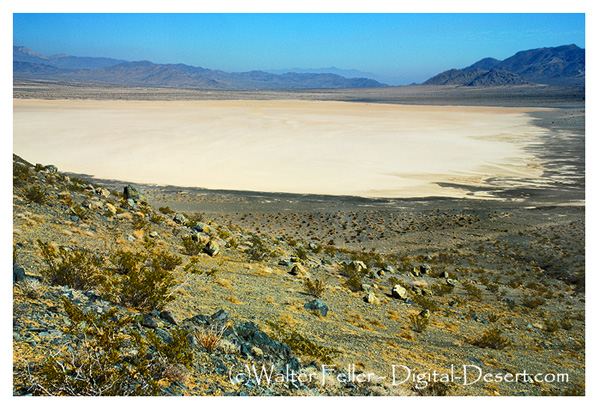Subsection 322Ah
Mojave Valley - Granite Mountains
This subsection consists of about half upland, including pediments, and half alluvial plain. There are many small mountain ranges and hills with many different orientation patterns. The subsection is bounded by the Garlock Fault Zone on the north, Avawatz Mountains on the northeast, Silurian Valley (outside of this subsection) on the east, the Soda Mountains on the southeast, Mojave Valley on the south, Harper Valley Fault on the southwest, and Rand Mountains on the west. It has a hot, arid climate. MLRA 30g.
Photo - Red Pass Dry Lake
Lithology and Stratigraphy
This subsection contains mainly Mesozoic plutonic rocks, Tertiary volcanic rocks, and Quaternary alluvium. Lacustrine and eolian sand deposits are common. The Mesozoic plutonic rocks are mostly granitic, but include some mafic rocks. There are areas of Quaternary volcanic, Tertiary nonmarine sedimentary, Pre-Cretaceous metamorphic, Paleozoic marine sedimentary, and Precambrian metamorphic rocks, too.
Geomorphology
This subsection is largely on very gently to moderately sloping pediments and alluvial fans and nearly level basin floor and dry lake bed. Less than half of the subsection is on steep mountains and moderately steep hills. Some of the dry lake beds are Bicycle, Coyote, East Cronese, West Cronese, Goldstone, Langford Wells, Leach, Manix, Nelson, Pilot Knob Valley, Red Pass, and Superior Lakes. The elevation range is from about 1080 feet on Cronese Lakes to about 5600 feet in the Avawatz Mountains. Mass wasting, fluvial erosion and deposition, and eolian deflation and deposition are the main geomorphic processes.
Soils
The upland soils are mostly shallow Typic Torriorthents on granitic rocks and Typic Haplargids on volcanic rocks. Also, there are “badlands” on Miocene marine sedimentary rocks. Soil on floodplains and on younger fans are Typic subgroups of Torrifluvents, Torripsamments, and Torriorthents. Those on older fans are Typic Torriorthents, Typic Haplargids, and Durinodic Calciargids. Soil on basin floor and dune sand are Typic Torriorthents and Typic Torripsamments. The soils are well drained, except on poorly drained playas. Soil temperature regimes are thermic; and soil moisture regimes are aridic.
Vegetation
The predominant natural plant community is Creosote bush series on hills, pediments, and fans. Joshua tree series is common on pediments and fans. Black bush series occurs at higher elevations, particularly in the Avawatz Mountains. Mixed saltbush series is common on basin floor and Iodine bush series and Saltgrass series are present on wet basin-fill and lacustrine deposits. Greasewood series occurs in riparian areas and around saltmarsh. Catclaw acacia series is common along the Mojave River.-
Characteristic series by lifeform include:
Grasslands: Alkali sacaton series, Big galleta series, Desert needlegrass series, Desert sand verbena series, Indian ricegrass series, Saltgrass series.
Shrublands: Allscale series, Brittlebrush series, Creosote bush series, Creosote bush - white bursage series, Desert-holly series, Fourwing saltbrush series, Greasewood series, Hop-sage series, Iodine bush series, Joshua tree series, Mixed saltbush series, Mojave yucca series, Rubber rabbitbrush series, Scadscale series, Spinescale series, White bursage series, Winter fat series.
Forests and woodlands: Mesquite series.
Climate
The mean annual precipitation is about 4 to 6 inches. It is mostly rain. Mean annual temperature is about 55° to 70° F. The mean freeze-free period is about 200 to 300 days.
Surface Water
Runoff is rapid from mountains and alluvial fans and slow from basin-fill. All drainage is internal, to closed basins in the Mojave Desert. The Mojave River, the only large stream in the western Mojave Desert, drains toward Cronese Valley, or toward Soda Lake. During the Pleistocene it drained through Silurian Valley to Death Valley. Streams are dry most of each year, and most of the water in the Mojave River drains beneath the river bed, surfacing only where there are bedrock constrictions, such as in Afton Canyon. There is temporary ponding on playas, or dry lake beds. < previous - Mojave Desert - next >
clickable map - select a section to view